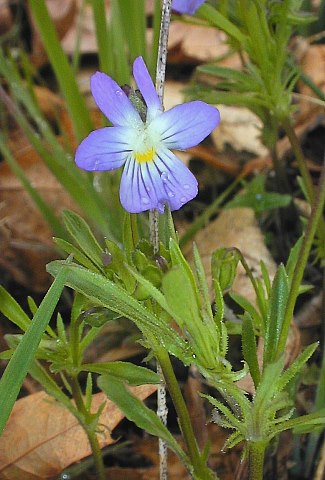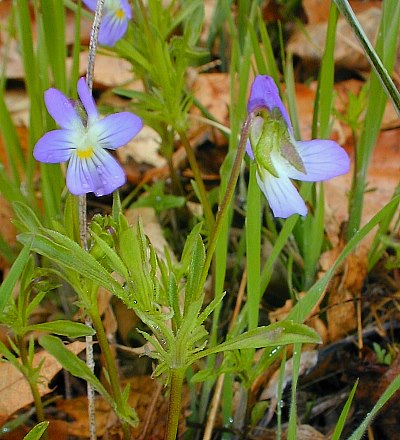Description:
This wildflower is a winter or spring annual about 6" tall,
sometimes branching near the base of the plant; it is more or less
erect. The small basal leaves have orbicular blades with long slender
petioles; these are followed by alternate leaves along the stems. The
stems are light green to purplish green and hairless. The alternate
leaves
are obovate, oblanceolate, or linear-oblanceolate, becoming more narrow
as they ascend the stems. They are
up to 2" long, light to medium green, hairless, and smooth to slightly
crenate along their margins. Leafy stipules up to 1" long occur along
the stems near the bases of the leaves. These stipules have deep narrow
lobes that are smooth or ciliate along their margins; they are light to
medium green like the leaves. Occasionally, individual flowers are
produced from axils of the upper leaves on long naked stalks. Each of
these stalks is light green to dark purple and hairless, curving
downward at the apex where the flower occurs. Each flower is about ½"
across, consisting of 5 petals and 5 sepals. The petals are pale to
medium blue-violet with dark purple lines, becoming white near the
throat of the flower. However, the lowermost petal has a patch of
yellow near its base. Also, the two lateral petals are bearded with
white hairs near the throat of the flower. The sepals are smaller in
size than the petals; they are light green to purplish green,
lanceolate, and hairless. The blooming period occurs from mid-spring to
early summer and lasts about 1½ months. Fertilized flowers produce seed
capsules. The small seeds are light brown and globoid; they are ejected
mechanically from their ripened capsules. The root system consists of a
slender branching taproot. Colonies of plants are occasionally formed.
and hairless. The alternate
leaves
are obovate, oblanceolate, or linear-oblanceolate, becoming more narrow
as they ascend the stems. They are
up to 2" long, light to medium green, hairless, and smooth to slightly
crenate along their margins. Leafy stipules up to 1" long occur along
the stems near the bases of the leaves. These stipules have deep narrow
lobes that are smooth or ciliate along their margins; they are light to
medium green like the leaves. Occasionally, individual flowers are
produced from axils of the upper leaves on long naked stalks. Each of
these stalks is light green to dark purple and hairless, curving
downward at the apex where the flower occurs. Each flower is about ½"
across, consisting of 5 petals and 5 sepals. The petals are pale to
medium blue-violet with dark purple lines, becoming white near the
throat of the flower. However, the lowermost petal has a patch of
yellow near its base. Also, the two lateral petals are bearded with
white hairs near the throat of the flower. The sepals are smaller in
size than the petals; they are light green to purplish green,
lanceolate, and hairless. The blooming period occurs from mid-spring to
early summer and lasts about 1½ months. Fertilized flowers produce seed
capsules. The small seeds are light brown and globoid; they are ejected
mechanically from their ripened capsules. The root system consists of a
slender branching taproot. Colonies of plants are occasionally formed.
Cultivation:
The preference is full or partial sun, moist to mesic conditions, and a
light friable soil containing some sand. However, this wildflower
adapts to other kinds of soil as well.
Range & Habitat:
The native Field Pansy is occasional in the southern half of Illinois
and
uncommon or absent in the northern half of the state (see Distribution
Map). Habitats include
limestone glades, moist sand prairies, fields, edges of sandy paths,
and waste places. Sandy
areas with a history of disturbance are preferred.
Faunal Associations:
The nectar and pollen of the flowers attract mostly bees, although
small butterflies and skippers may also visit the flowers. The
caterpillars of various Fritillary butterflies (Boloria spp.,
Speyeria spp., etc.) and moths feed on the foliage
of Viola spp. (Violets). The seeds are eaten in
limited amounts by the Ruffed Grouse, Bobwhite, Wild Turkey, Mourning
Dove, and some songbirds. Violets are not a preferred food source of
mammalian herbivores, although rabbits and deer will browse on the
foliage occasionally.

Photographic
Location:
Edge of a sand prairie in Kankakee County, Illinois.
Comments:
In the past, there has
been some controversy regarding whether or not the Field Pansy is
native to North America as it shares many characteristics with annual Viola spp.
from Eurasia. More recently, there is a growing consensus among
botanists that the Field Pansy is sufficiently distinct to be
considered a native species of North America. The Field
Pansy is rather similar to the introduced Viola
tricolor (Johnny Jump-Up). However, this latter species has
larger tricolored flowers about ½–1" across and the terminal lobes of
its stipules tend to have more teeth. Another introduced species, Viola
arvensis
(Wild Pansy), has yellow-cream flowers and its sepals are at least as
long as its petals. Like the Field Pansy, these introduced
species
produce large stipules that are deeply lobed; this pansy-like
characteristic distinguishes them from the Viola spp. that are
called violets. A
scientific synonym of the Field Pansy is Viola rafinesquii.